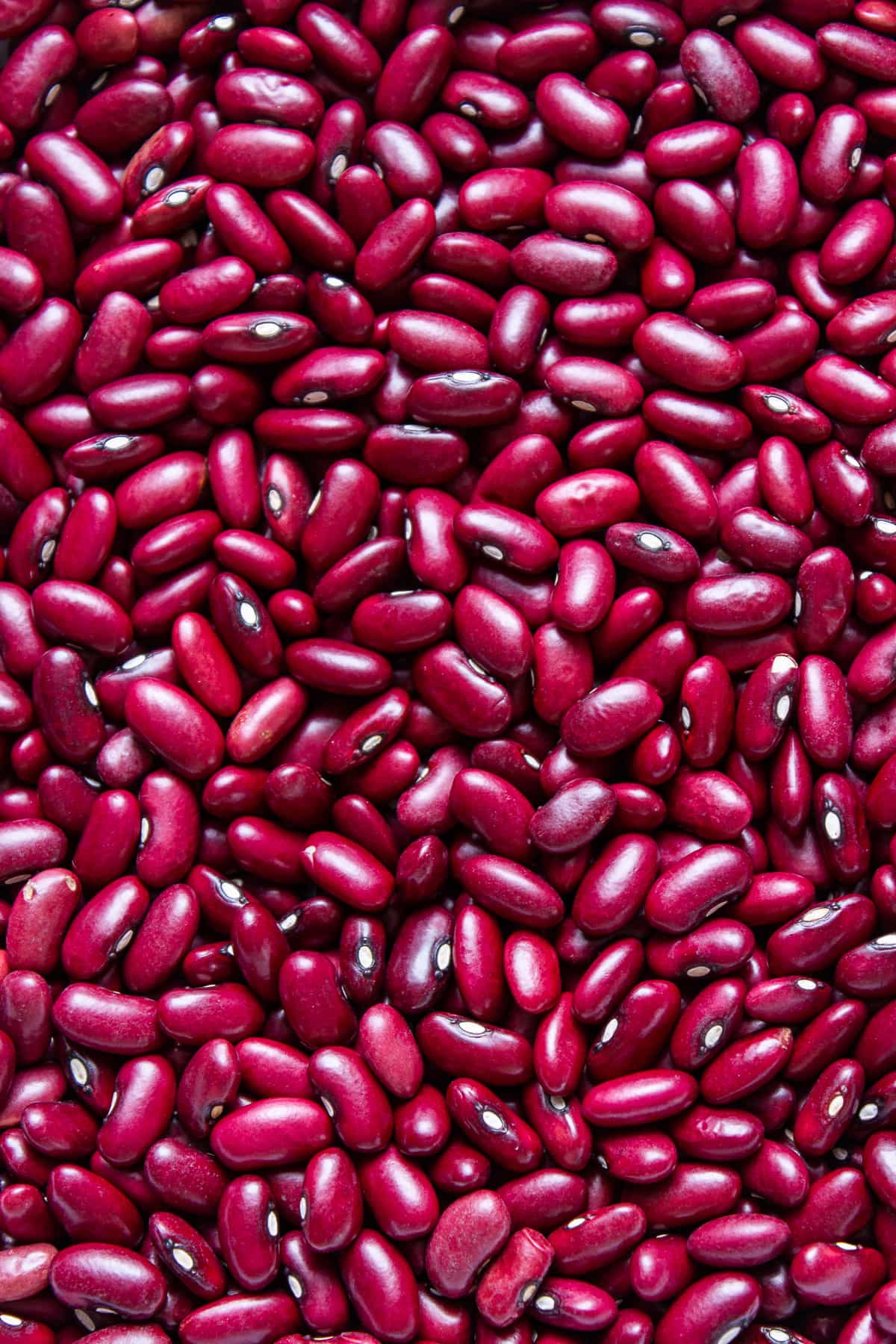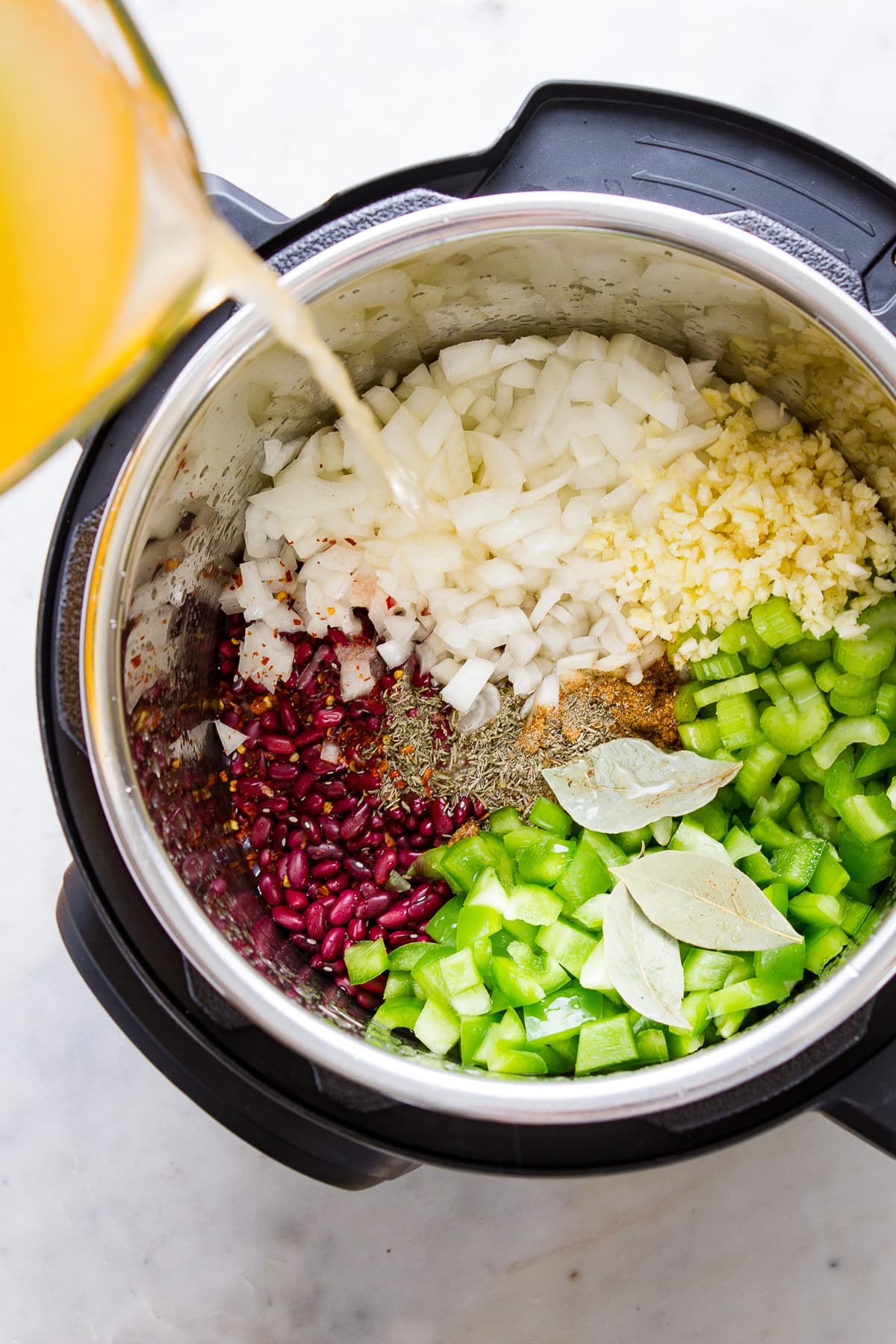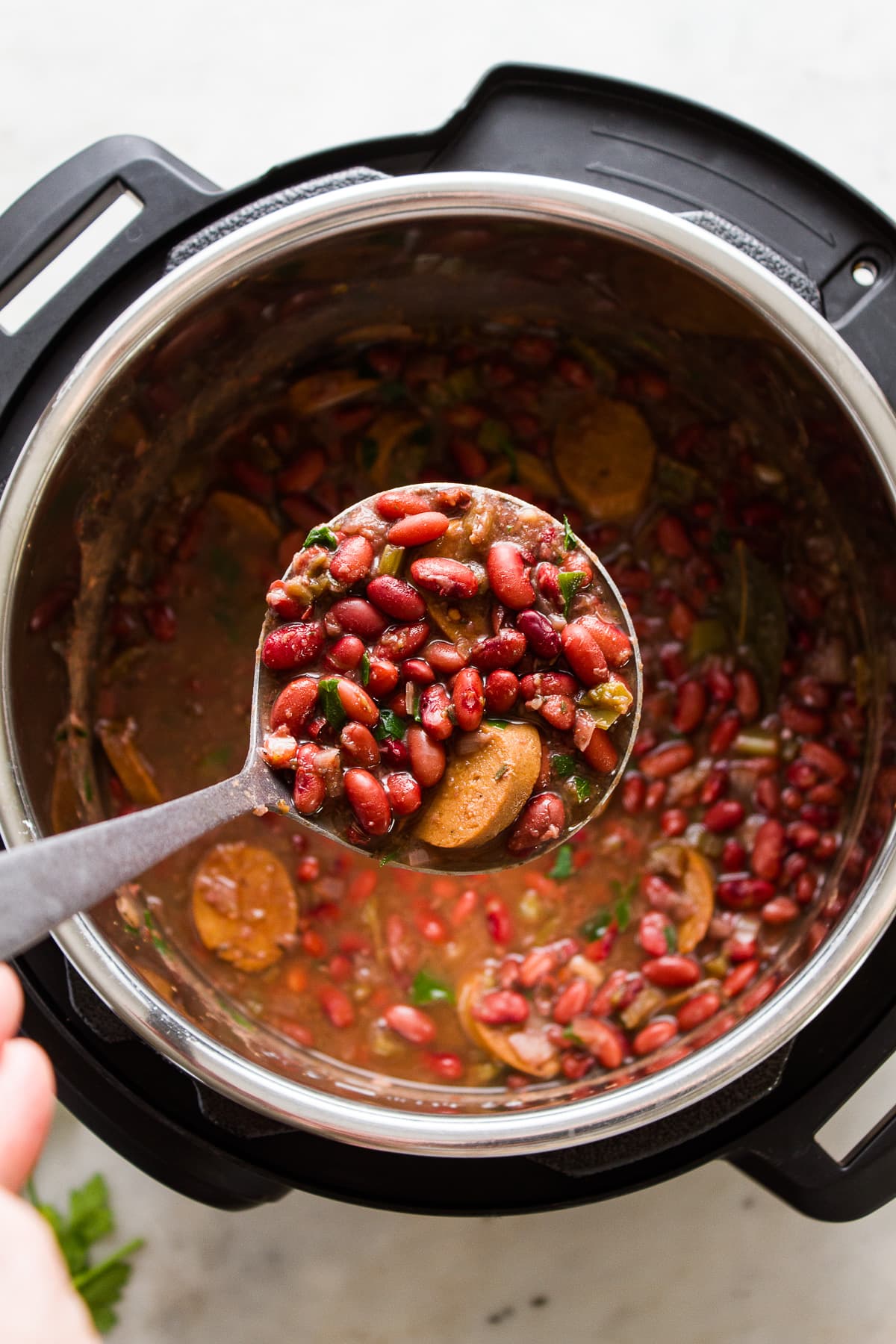Instant Pot Red Beans and Rice (Vegan)
Instant Pot Red Beans and Rice features red beans cooked from scratch with veggies, flavorful Cajun spices, and vegan sausage and served with rice for a healthy & hearty lunch, dinner, or meal prep!

Pressure cookers are simply wonderful. If you already have one, know what I mean. Like a slow cooker, you simply dump it and forget it, but a pressure cooker works much faster (plus, the Instant Pot has a slow cooker mode, too!).
I’ve been making beans like crazy in my pressure cooker over the last month, like these Instant Pot Black Beans and Instant Pot Refried Beans. And I’m thrilled to have this Instant Pot Red Beans and Rice recipe to add to the collection!
This red beans and rice recipe is a new family favorite. It’s easy to make and ready in a little over an hour. It’s a hearty vegan dinner that’s full of flavor and delicious!
I hope you enjoy this plant-based recipe as much as we do. It’s super healthy, oil-free, low-fat, and gluten-free, so you can enjoy your meal and feel good about what you’re eating!
This post may contain affiliate links.

Ingredient Notes
Here are some of my favorite ingredients for making the best vegan red beans and rice. Plus, you’ll find tips and substitutions for customizing the recipe to your needs.
- Red Beans: You’ll need 1 lb. dried small red beans or red kidney beans in this recipe. It’s traditional to use small red beans, but red kidney beans are just as good and easily accessible if you can’t find them. There is no need to soak or drain the beans – YAY! (see below)
- Veggies: Aromatics include a yellow onion and a few garlic cloves. We’ll be adding a couple of stalks of celery and green bell pepper for extra heartiness. Feel free to add an extra bell pepper for more heartiness and fiber.
- Spices: We’ll use a few essential spices and herbs typically found in Cajun cuisine, such as dried oregano and thyme, smoked paprika, cayenne (or hot sauce), bay leaves, and a good dose of Cajun seasoning blend. If you don’t have Cajun or Creole spice blends on hand, add 1 extra teaspoon of oregano, thyme, and smoked paprika.
- Liquids: Use water or vegetable broth. For maximum flavor, use vegetable broth. The beans will soak it up, adding another layer of flavor when cooking. To cut down on cost and sodium, I use 1 teaspoon of Better Than Bouillon Vegetable Base to the 4 cups of water called for. It adds just the right amount of flavor.
- Vegan Sausage: Sausage will add more protein and heartiness and is optional. Tofurky’s Andouille is great, but any of Tofurky’s or Field Roast sausages will be great. I don’t care to cook the sausage with the beans and prefer to add it at the end, letting it warm up with the hot bean mixture. I find the pressure cooker gives it a weird texture.
- Rice: Use your favorite rice – white, brown, or even forbidden black rice would be great. And if you prefer using quinoa as your grain, that works too.
- Garnish: Fresh chopped parsley, green onions, and a squeeze of lime add a nice finishing touch. A dollop of Vegan Sour Cream would also be great!

How To Make Instant Pot Red Beans & Rice
Making homemade vegan red beans and rice in the instant pot only requires a few simple steps:
- Start by washing the beans. Rinse the beans under cool running water using a colander. Pick out and remove any odd-shaped beans.
- Add ingredients to the instant pot. Place the red beans in the bowl of the instant pot, along with the remaining ingredients (except the sausage and parsley), finishing with the liquids.
- Pressure cook the beans. Manually set the Instant Pot to HIGH pressure for 60 minutes (kidney beans will need 70 min), and close the vent to SEAL. Once done, let the pressure cooker steam vent naturally for about 20 – 25 minutes.
- Add vegan sausage and taste for flavor. Add vegan sausage (if using) and parsley and taste for flavor. Some recipes call for mashing some of the beans against the wall of the pot with the back of a fork. This will help thicken the liquids making a gravy of sorts. For myself, I love it just as it is.
- Cook the rice. While the beans are pressure cooking, make the rice according to package directions using at least 1 cup of rice.
Now all you have to do is enjoy the best red beans and rice ever!
Top Tips
- This recipe uses unsoaked red beans and was made using a 6 qt. Instant Pot. If using an 8 qt., you may need to add additional cooking time (10 – 20 minutes).

Serving Suggestions
We love to pair this red beans & rice recipe with our Vegan Cornbread or Jalapeno Cornbread Muffins. It’s perfect on the side or crumbled on top of your serving!
How Long Will Leftovers Keep?
Leftovers can be stored for 5 – 6 days in the refrigerator in a covered container. Re-warm on the stovetop or the microwave. It makes great meal prep for the week with a grain like rice or quinoa on the side.
Can You Freeze Red Beans and Rice?
Yes, it freezes wonderfully for up to 2 months! My favorite way to freeze cooked red beans & rice is to individually store them in serving-size portions using freezer-safe containers. You can also freeze larger portions in large ziplock bags or containers.

More Instant Pot Recipes!
- Cuban Black Beans + Mango Bowl
- The Best Ever Baked Beans
- Instant Pot Refried Beans
- Instant Pot Applesauce
- See all pressure cooker recipes on TSV!
If you try this red beans and rice recipe, please let me know! Leave a comment and rate it below. I love to hear what you think, or any changes you make.
PrintInstant Pot Red Beans and Rice
Red Beans and Rice features red beans cooked in an Instant Pot from scratch with veggies, flavorful cajun spices, vegan sausage, and served with rice for a healthy & hearty lunch, dinner, or meal prep!
- Prep Time: 10 min
- Cook Time: 80 min
- Total Time: 1 hour 30 minutes
- Yield: Serves 4 – 6 1x
- Category: Entree
- Method: Instant Pot
- Cuisine: Vegan, Cajun
Ingredients
- 1 lb. dried red beans or kidney beans (about 2 cups), rinsed and odd beans removed
- 1 large yellow onion, diced
- 5 cloves garlic, minced
- 1 large green bell pepper, cored and diced
- 3 – 4 celery ribs, sliced
- 1 tablespoon cajun or creole seasoning
- 1 teaspoon EACH oregano, thyme and smoked paprika
- 1 teaspoon hot sauce, tabasco or sriracha or 1/2 teaspoon red pepper flakes or cayenne
- generous pinch of mineral salt & pepper
- 2 – 3 bay leaves
- 4 cups water or low sodium vegetable broth
- vegan sausage, optional
- 1/4 cup fresh parsley, chopped
To serve
- 3 cups of cooked rice (use your favorite rice or quinoa)
- chopped parsley
- green onions
- lime wedges
Instructions
Start by washing the beans. Rinse the beans under cool running water using a colander. Pick out and remove any odd shaped beans (no soaking required).
Add ingredients to the instant pot. Place the red beans in the bowl of the instant pot, add the onions, bell pepper, bell pepper, garlic, oregano, cajun seasoning, bay leaves, salt, pepper and finish with the liquids.
Pressure cook the beans. Manually set the Instant Pot to HIGH pressure for 60 minutes (if using kidney beans cook 70 min), close the vent to SEAL. Once done, let the pressure cooker steam vent naturally for about 20 – 25 minutes.
Add sausage and taste for flavor. Remove the bay leaves. Add the optional sausage and parsley. Taste for flavor, adding as much salt and pepper as you like. Beans will soak up the remaining liquids as they cool. For a thicker sauce like gravy, mash some of the beans against the wall of the instant pot bowl with the back of a fork.
Cook the rice. While the beans are pressure cooking, make the rice according to package directions using at least 1 cup of rice.
Serves 4 – 6
Pairs well with this Vegan Cornbread or Jalapeno Cornbread Muffins on the side!
Store: Leftovers will keep for 5 – 6 days in the refrigerator, stored in a covered container. To keep longer, store in the freezer using freezer safe containers for 2 – 3 months. Let thaw in the refrigerator. Re-warm on the stovetop or the microwave.
Notes
If you don’t have cajun or creole seasoning on hand, use an extra 1 teaspoon of oregano, thyme, and smoked paprika.
This recipe is made with a 6qt. pressure cooker. If using an 8qt, you may need additional cooking time (up to 20 minutes).
RECOMMENDED EQUIPMENT: I used this 6qt. Instant Pot, and for storing and keeping warm this glass instant pot lid is perfect (affiliate links).
Nutrition information calculates using 1 cup of dried rice.
FOLLOW TSV on Facebook, Instagram, Pinterest, Youtube, Subscribe (email), or RSS for more recipes and inspiration!


Outstanding recipe. Other than adding more garlic and using red onion instead of a yellow one, I made it exactly as written. TY for sharing. This is a keeper as it is so flavorful. So thankful for leftovers!!
(I originally posted this incorrectly under the jalapeño muffins recipe which I haven’t made YET)
So glad you enjoyed the recipe, Suze! Yay for leftovers, they will be even better. I’ve removed your accidental comment from the muffins (hope those are a winner too). Thanks so much for sharing!
If I use can beans how time I give
Great question, Urban! If using canned beans, we recommend the following changes to the recipe:
3 cans beans, drained and rinsed
2 cups of broth or water (instead of 4 cups)
Cook in the Instant Pot as directed for 3 minutes.
I hope that helps. Enjoy!
60m?? I cook them for 16m and they’re soft… whole point of the IP, saving time.
Sorry if it seems not as fast as your cooking time, El! This recipe calls for un-soaked red or kidney beans, which takes longer to cook so that may be the reason for the longer cook time. I hope that helps and you can make the recipe with dried beans for a perfect outcome.
I was making 2 batches, one regular (my daughter wanted to use our slow cooker), one vegan. Since this was a last minute decision I already had 2 batches of beans soaking. How long should I pressure?
If using soaked red beans, I would pressure cook for 15 minutes. I hope that helps. Enjoy!
Delicious! I left out the hot sauce since my kids were eating this too. It was very good! My family of 5 all liked it.